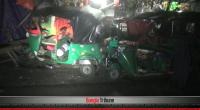 When a storm starts forming the Met office uses different codes of signals warnings the maritime and river ports and advising people to stay safe. These signals define the intensity of storm as well as potential impact and damage.
When a storm starts forming the Met office uses different codes of signals warnings the maritime and river ports and advising people to stay safe. These signals define the intensity of storm as well as potential impact and damage.
“These signals, in fact, are meant for maritime and river ports. It’s not a big deal if the general people have not adequate knowledge,” argued disaster management specialist Gowhar Naim Wara.
The Bangladesh Meteorological Department (BMD) issue several types of signals when a storm starts to develop in the Bay of Bengal.
The signal numbers in the two codes do not carry the same significance and, in particular, that higher signal numbers within the danger and great danger maritime groups indicate differences in storm location not difference in storm intensity.
Storm warning signals for use at maritime ports
a) Distant signals
No. 1 Cautionary:
There is a region of squally weather in which a storm may be formed.
No. 2 Warning:
A storm has formed.
b) Local signals
No. 3 Cautionary:
Port is threatened by squally weather.
No. 4 Warning
Port is threatened by a storm, but danger not yet sufficiently great to justify extreme precautionary measures.
No. 5-7 Danger:
Port will experience severe weather from a storm of slight or moderate intensity.
5. Storm expected to cross the coast to the south of the port.
6. Storm expected to cross the coast to the north of the port.
7. Storm expected over or near the port.
No. 8-10 Great danger. Port will experience severe weather from a storm of great intensity.
8. Storm expected to cross the coast to the south of the port.
9. Storm expected to cross the coast to the north of the port.
10. Storm expected over or near the port.
Failure of communication: Communications with the meteorological warning centre have broken down and the local officer considers that there is danger of bad weather.
 Storm warning signals for use at river ports:
Storm warning signals for use at river ports:
1. Cautionary: Area threatened by squally winds. Look out for further developments.
2. Warning: A storm or norwester is likely to strike the area.
3. Danger: A storm will soon strike the area. All vessels seek shelter immediately.
4. Great danger: A violent storm will soon strike the area.
Red flag
A red flag is hoisted indicating distance warning signal no. 1 to 3.
Two red flags are hoisted advising indicating cautionary signal no. 4 to 7.
Three red flags are hoisted indicating Great danger signal no 8 to 10 and failure of communications between meteorological warning centre and the local officer.
The signal codes can help “people involved in the ports stay aware,” said disaster management specialist Gowhar Nayeem Wara before adding nowadays’ technology forecast the storm and in which direction it would hit.
“We should pay heed [to modernise the metrological technology],” he added.


